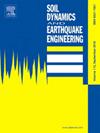Comprehensive seismic risk assessment of mountainous road networks under concurrent impact of earthquakes and water presence
IF 4.2
2区 工程技术
Q1 ENGINEERING, GEOLOGICAL
引用次数: 0
Abstract
Seismic risk assessment of road networks is crucial for ensuring infrastructure resilience and enhancing informed decision-making and retrofits in earthquake-prone regions. This study aims to evaluate the seismic risk associated with retaining walls and cut slopes in three districts of northern Greece, with a particular focus on the impact of water presence. A comprehensive exposure model is developed, identifying key components along the examined road axes. Existing probabilistic seismic hazard analysis results are employed for all regions, supplemented by deterministic analyses with seismic scenarios of 475- and 955-year recurrence periods for Xanthi regional unit. Novel fragility curves for gravity retaining walls and cut slopes are proposed, while existing ones are applied for reinforced concrete retaining walls. Risk analyses are conducted for peak ground acceleration (PGA) and peak ground velocity (PGV). The probabilistic analyses outcomes reveal the critical importance of considering water presence in seismic risk assessment, identifying districts with higher level of seismic risk. Scenario-based analyses indicate that, while all elements are likely to experience minor damage under dry conditions, the presence of water leads to moderate and extensive damage for several cut slopes and retaining walls. Finally, the study emphasizes the need for targeted mitigation strategies to enhance the resilience of road infrastructure.
求助全文
约1分钟内获得全文
求助全文
来源期刊

Soil Dynamics and Earthquake Engineering
工程技术-地球科学综合
CiteScore
7.50
自引率
15.00%
发文量
446
审稿时长
8 months
期刊介绍:
The journal aims to encourage and enhance the role of mechanics and other disciplines as they relate to earthquake engineering by providing opportunities for the publication of the work of applied mathematicians, engineers and other applied scientists involved in solving problems closely related to the field of earthquake engineering and geotechnical earthquake engineering.
Emphasis is placed on new concepts and techniques, but case histories will also be published if they enhance the presentation and understanding of new technical concepts.
 求助内容:
求助内容: 应助结果提醒方式:
应助结果提醒方式:


